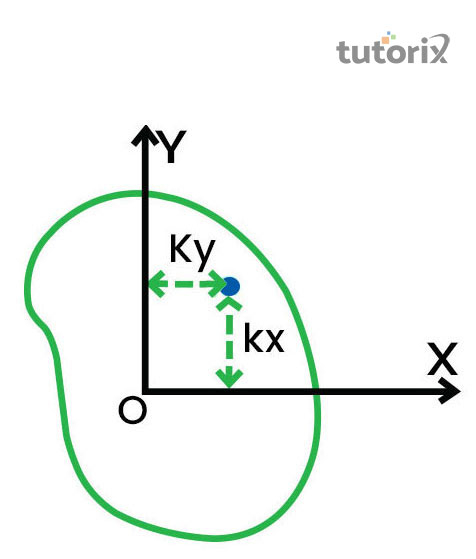Introduction
The radius of gyration of an object about the axis of its rotation is generally defined as the radial distance. This distance is associated with a point which would have a moment of inertia. This moment of inertia would be equal to the actual mass distribution of the particular body, in case the total mass of the body were to be concentrated at that point.
The radius of the gyration is useful in various subjects throughout the daily course of life, especially in the field of engineering. In real life, this is used to study the rigidity of a column. The radius of gyration is also termed gyroradius.
What do you mean by Radius of gyration?
The radius of gyration of a body often represents the moment of inertia of a particular body around its particular axis. It can however be defined differently, thus it is to be noted that the radius of gyration can be considered as a hypothetical distance from the centroid of an object (Shaheen et al. 2018).
This centroid is associated with the area of cross-section which is imagined to be concentrated at a particular point, to obtain the same moment of inertia. This radius of gyration is generally defined by k.

Figure 1: Radius of gyration
Explore our latest online courses and learn new skills at your own pace. Enroll and become a certified expert to boost your career.
What is the mathematical description for the radius of gyration?
Mathematically, it can be noted that the radius of gyration is associated with the root mean square distance of the parts of a particular body. It can be from the centre of mass of a particular axis, it depends on the relevance of the mathematical application (Khatiwada, 2020). It is to be noted that it is the perpendicular distance from the point of mass associated with the axis of rotation (Haydukivska et al. 2020).
An individual can represent the trajectory of a moving point as a body. In such conditions radius of gyration can be used to define the typical distance travelled by this particular point which has been represented as an object.
What is the formula for radius of gyration?
The formula associated with the moment of inertia in terms of radius of gyration is given in the following manner
I = mk2 ……… (eq. 1)
In this case, I is the moment of inertia of a particular body and m is associated with the mass of the body
Hence, according to this method the radius of gyration is mentioned in the following manner.
K = √I/m …….. (eq. 2)
The radius of gyration is associated with the unit, mm. As opined by Alsaker et al. (2019), by obtaining the radius of gyration an individual can find the moment of inertia of a solid body. The formula for the part is demonstrated for better understanding.
If a body has n number of particles with the mass of m, the perpendicular distance in front of the axis of the rotation is represented by r1, r2, r3… rn. Now we know that the moment of inertia for a radius of gyration can be obtained from equation 1. There, by substitution, we can get,
I = m1r12 + m2r22+ m3r33…… + mnrn2………. (eq. 3)
In case all the particles possess the same amount of mass, then
I = { mn(r12 + r22+ r33 + ……..+ rn2 ) }/n
We can further write mn as ‘M’
From there on we can get,
MK2 = M { (r12 + r22 + r33 +……………. + rn2)/n }
Or K = √ (r12 + r22+ r33 +……………………+ rn2)/n
Therefore, it can be concluded that the radius of gyration can also be represented as the root-mean-square distance of several particles of a particular body from its particular ‘axis of rotation.

Figure 2: Radius of gyration
What is the real-life application of radius of gyration?
The radius of gyration can be utilized to make a comparison of how several structures of different shapes will behave when out under compression along a particular axis. This can be used to predict the bulking process in case of a compression beam
The aspect of radius of gyration is also used in the case of geographical data analysis. According to Gurnev et al. (2020), it is used to calculate various sets of statistics including the spread of various geographical locations. It is also used in the case of polymer physics where it is used to define the dimensions of polymer chains.
Conclusion
The radius of gyration has several real-life applications across various branches of structural analysis. The aspect of gyration radius is useful in the process of determination of the moment of inertia about its rotational axis of a body equal to the actual distribution of the mass of the body. It is associated with the radial distance to a point. However certain criteria are required to be met, that is the moment of inertia can be the same as the actual mass distribution for a body in case the total mass of the body is to be concentrated in that region.
Leave a Reply